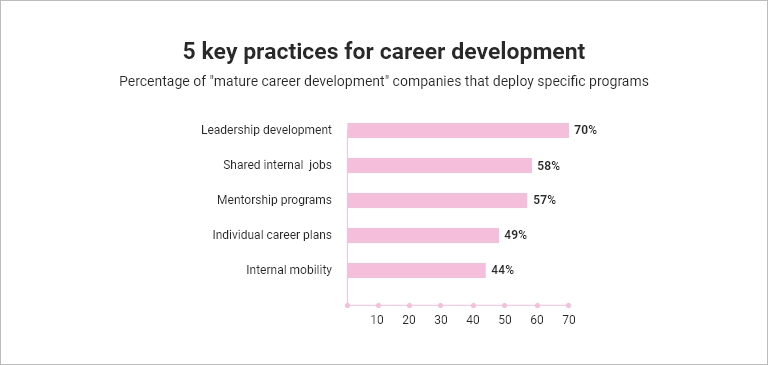The business world is ever-changing, making strong leadership vital for any successful company. Leaders define the course, engage employees, and drive goal achievement. Therefore, cultivating capable leaders isn’t merely beneficial; it’s central to safeguarding the organization’s future. For example, L&D leaders must foster a sense of purpose and growth within their teams. Motivating and empowering their trainers and designers creates engaging learning experiences that benefit the entire organization.
While leadership development often needs a more systematic approach within companies, there’s a wide array of formal and informal methods. Although costs are involved, successful businesses understand that these investments have a direct impact on their bottom line.
The Essence of Leadership
Real leadership isn’t about authority; it’s about shaping mindsets. It’s about setting a course, igniting passion in others, and working together to achieve extraordinary goals. True leaders live by the organization’s values, empowering their teams to make meaningful contributions. They coach, inspire, and create a culture of ownership.
At Infopro Learning, ourLeadership Development Programs extend across various dimensions to unlock your organization’s full potential. Our diverse range of tailored corporate leadership development programs assists organizations in unlocking potential across multiple facets, including learning strategies, skill transformation, team development, customer focus, and the future of work.
We craft customized solutions by harnessing our extensive knowledge of corporate leadership development methodologies and leveraging our global team of executive coaches, learning strategists, instructional designers, and facilitators.
Remember, leadership is a skill anyone can cultivate—from those excelling in their roles to those always seeking innovation. While good management is essential, leadership is about transforming vision into reality.
Here are a few reasons why organizations should prioritize leadership development:
- Strategic Alignment: Effective leaders align their teams, departments, and individual efforts to the overarching organizational goals. This ensures everyone is working in unison towards a common purpose. Unlock the secrets to transforming your team into a high-performance powerhouse from the infographic ‘Secrets to Building High-Performing Teams That Achieve Triumphant.’
- Employee Engagement and Motivation: Great leaders inspire motivation and create positive workplaces, driving employee engagement, productivity, loyalty, and business success.
- Problem-solving and Innovation: Talented leaders possess strong problem-solving skills and can think innovatively. They encourage calculated risk-taking and experimentation, resulting in novel solutions to challenges and the generation of new ideas.
- Change Management: Adaptability is the key to surviving in today’s world. Leaders skilled at navigating uncertainty and managing change give their teams a distinct edge.
- Talent Retention: Employees want to work for inspiring leaders. Focusing on leadership development leads to a more positive work culture and can significantly boost talent retention.
Crafting an Effective Leadership Development Strategy
There’s a critical need for leadership development across the workforce and within HR. This presents a unique opportunity for HR professionals to take the lead. Investing in ongoing training and professional development empowers employees to lead with skill and confidence.
Companies of varying sizes will naturally approach this differently. Smaller organizations may begin with informal programs, while larger ones might build robust in-house leadership programs.
According to LinkedIn’s 2024 Workplace Learning report, the following image details the most popular career development programs offered by companies, along with the percentage of companies utilizing each program.

The bottom line: As companies anticipate the complexities of the future, HR professionals have an unprecedented chance to shape and implement the leadership development programs that will pave the way.
Boost your leaders’ skills with ‘Leadership Launchpad: Essential Skills for First-Time Leaders‘. This webinar replay, featuring Dan Rust, Head of Global Leadership and Organizational Development, is designed specifically for those transitioning into leadership for the first time.
The key steps to building a successful leadership development strategy include:
Needs Assessment
- Align with Business Goals: What are the organization’s strategic priorities, and what leadership capabilities will drive those priorities?
- Skill Gap Analysis: Identify the strengths and weaknesses of current leadership capabilities and future needs.
- Leadership Competencies: Define the essential behaviors, knowledge, and skills required for your organization’s specific leadership context. Consider using a competency model.
Targeted Development Plans
- Individualized approach: Cater to the developmental needs of specific leaders, tailoring programs for different levels (emerging, mid-level, senior).
- Diverse methods: Blend various learning experiences:
- Formal training (workshops, courses)
- Coaching and mentoring
- Job rotations, stretch assignments
- Action learning projects
- 360-degree feedback
Stakeholder Engagement
- Secure Buy-in: Actively involve senior leadership for support, inspiration, and resource allocation.
- Participant Commitment: Ensure potential leaders understand the value and are engaged in actively pursuing their own development.
- Manager Support: Managers are essential for coaching, giving on-the-job feedback, and strengthening employee learning.
Program Design and Delivery
- Relevance: Focus on real-world business challenges and scenarios.
- Experiential Learning: Prioritize hands-on experiences for faster skill acquisition.
- Blended Learning: Leverage a mix of online and in-person components for flexibility and accessibility.
- Leadership Culture: Build development activities into the organization’s day-to-day operations to foster a culture of continuous learning and growth.
Evaluation and Measurement
- Define Success: Establish clear metrics based on the original business goals and individual plans (e.g., behavioral change, improved KPIs).
- Iterate: Gather feedback from participants, managers, and stakeholders. Adjust the program consistently for improvement.
- Demonstrate ROI: Analyze the impact of the development strategy on business results to secure continued support.
Additional Best Practices
- Succession Planning: Connect leadership development to your succession planning strategy, ensuring a pipeline of qualified leaders.
- Focus on Soft Skills: Prioritize the development of essential “people skills” like communication, emotional intelligence, collaboration, and adaptability.
- Diversity and Inclusion: Ensure inclusive programs offer equitable opportunities and foster a diverse leadership team.
Deloitte’s report highlights a troubling disconnect: 55% of CEOs see leadership development as their biggest challenge, while 63% of millennials feel their employers aren’t preparing them to fill these roles. Some newly promoted leaders are unprepared for success because of flawed succession planning.
Many companies create lists of potential candidates and corresponding open positions. This narrow approach fails to identify and address crucial skill gaps that can trip up promising leaders. More importantly, it neglects the vital transformation from manager to leader, leaving these individuals without the necessary capabilities to thrive in their new roles.
Conclusion
The ever-changing business landscape demands adaptable, inspiring leaders who can steer their organizations toward success. Leadership development is a strategic imperative, not an extravagance. By prioritizing leadership development, companies cultivate a forward-thinking workforce, create a culture of engagement, and boost their ability to achieve strategic goals.
The time for action is now. Embrace tailored programs, foster continuous learning, and remember that leadership transcends titles – it’s about empowering individuals at every level of your organization to drive meaningful change. The future belongs to those who invest in their leaders, unlocking their potential to create a better tomorrow.




